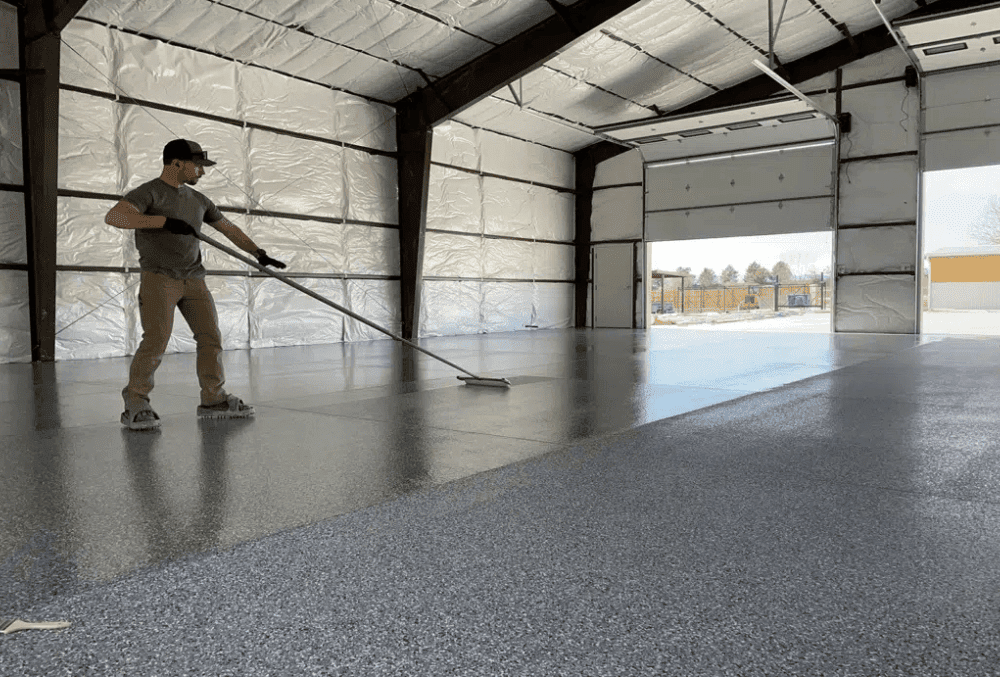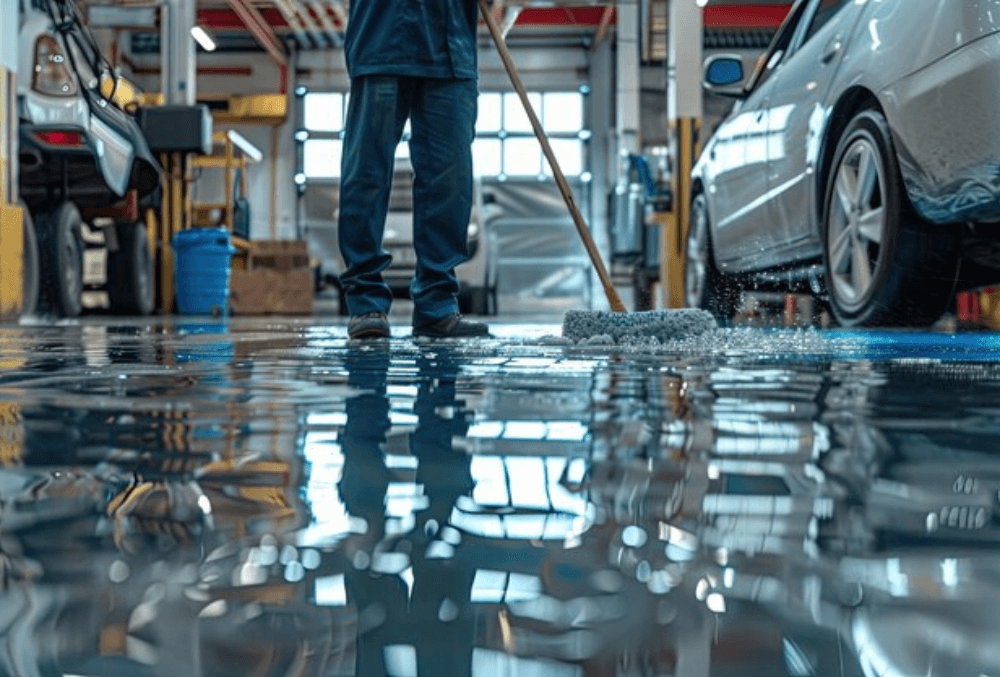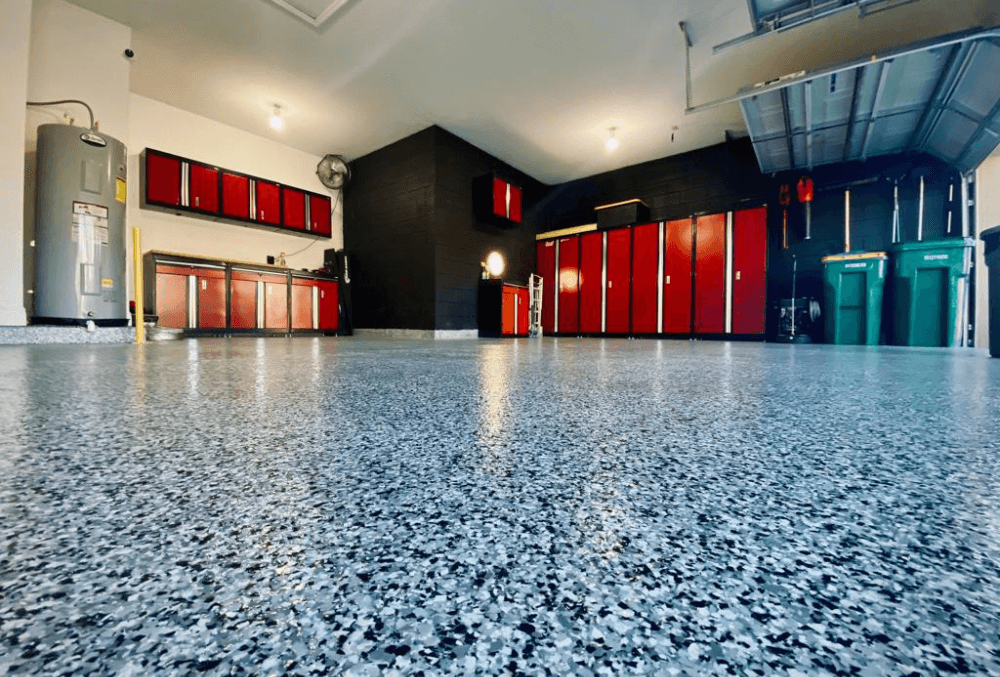Selecting the appropriate garage floor is crucial for improving both functionality and aesthetics within the home. There is a diverse range of materials to consider, from durable concrete options to elegant epoxy finishes.
This guide delineates the various types of garage flooring, offers preparatory steps for installation, and outlines what one can anticipate during the process.
Furthermore, it provides insights on how to maintain the newly installed floor effectively, ensuring its durability and visual appeal for years to come.

What are the Different Types of Garage Floors?
When considering garage floor installation, it is crucial to understand the range of options available, each presenting distinct benefits designed to enhance both functionality and aesthetics.
Traditional concrete floors are recognized for their durability, while advanced epoxy coatings offer a seamless and protective finish.
Interlocking tiles provide the advantages of easy installation and customization, whereas rubber mats contribute comfort and impact resistance.
Selecting the appropriate type of garage floor is essential for ensuring longevity, ease of maintenance, and the capacity to withstand heavy loads, all of which are significant factors in optimizing the overall efficiency of the garage space.
Concrete Floors
Concrete floors are the most common choice for garages due to their robust structure and ability to support heavy loads, making them an ideal option not only for garages but also for various other spaces in residential and commercial settings.
The advantages of selecting this flooring solution extend beyond mere strength. Concrete floors are remarkably cost-effective, making them an economically sound choice for both homeowners and businesses.
Their durability ensures they can withstand the test of time, resisting scratches, stains, and even moisture. Additionally, concrete coatings San Jose can provide further protection and enhance functionality within your garage space.
- Maintenance is straightforward and requires minimal effort to maintain their pristine appearance.
- Routine cleaning can be accomplished by simply sweeping or mopping with a mild detergent to eliminate dirt and grime.
- For any necessary repairs, it is essential to engage a qualified concrete contractor in San Jose, as their expertise guarantees proper installation and maintenance, thereby safeguarding the floor’s longevity.
Opting for concrete floors is a decision that yields significant benefits in both functionality and aesthetics.
They are also compatible with a range of protective coatings such as epoxy coatings, polyurethane coatings, and polyaspartic coatings, further enhancing their utility and appearance.
Epoxy Floors
Epoxy floors represent a highly regarded option for garage flooring, owing to their exceptional durability and protective characteristics.
This flooring type not only enhances the aesthetic appeal of a space but also offers significant resistance to chemical damage, which is particularly important for garages frequently exposed to oil, gasoline, and other hazardous substances.
The smooth surface of epoxy facilitates easy cleaning, requiring minimal effort to maintain its immaculate condition.
During the installation process, professionals typically commence with thorough surface preparation, including the use of epoxy primer and a protective sealer.
This step is crucial for ensuring that the epoxy adheres effectively, thereby providing enhanced longevity and durability.
Engaging local experts for epoxy flooring San Jose can greatly streamline the process, offering valuable insights and ensuring that the installation is executed correctly the first time.
Furthermore, this local expertise allows for quicker response times regarding any potential maintenance issues in the future, making it a pragmatic choice for homeowners.
Interlocking Tiles
Interlocking tiles represent a versatile flooring solution that facilitates easy installation and customization for any garage environment.
These tiles are available in an extensive range of styles and colors, enabling homeowners to showcase their individual taste and preferences.
Whether one chooses bold, vibrant hues or more subdued, neutral shades, the aesthetic appeal of interlocking tiles, often used in DIY projects, has the potential to transform an ordinary garage into a welcome and visually appealing space.
The installation process is straightforward, requiring no adhesive or specialized tools, which makes it a preferred option for DIY enthusiasts.
In terms of maintenance, interlocking tiles are easy to care for; regular sweeping and occasional mopping are sufficient to preserve their appearance.
Compared to other flooring alternatives, such as laminate or traditional concrete, interlocking tiles are distinguished by their durability and resistance to stains and moisture, ensuring they maintain their attractive appearance for many years.
Rubber mats represent a valuable addition to any garage, offering both comfort and protection for the flooring as well as the user.
Plus enhancing comfort levels, these mats provide exceptional slip resistance, making them an ideal option for areas susceptible to moisture and spills.
This characteristic is particularly advantageous when engaging in projects that involve liquids, as it significantly mitigates the risk of accidents.
Rubber mats also serve to protect the underlying flooring from potential damage caused by tools, equipment, or heavy objects, which can lead to costly repairs.
Furthermore, they harmoniously complement various flooring types, including polyurea polyaspartic floor coating San Jose solutions, resulting in a cohesive aesthetic while remaining easy to maintain.
To ensure their longevity, regular cleaning is essential; a simple wipe down with warm, soapy water will suffice. It is advisable to avoid harsh chemicals that could compromise the material’s integrity.
Additionally, periodic inspections for wear and tear will assist in identifying any areas that may require replacement.
By investing in rubber mats, users can cultivate a safer and more comfortable workspace, ultimately enhancing the overall efficiency of their garage activities.
How to Prepare for Garage Floor Installation
Preparing for garage floor installation is a crucial step in achieving a successful and enduring result, commencing with meticulous surface preparation and comprehensive planning, which includes understanding potential vapor emissions.
This phase entails evaluating the current condition of the existing flooring, executing necessary repairs, and thoroughly cleaning the area to remove debris and contaminants.
Engaging a professional installer will provide guidance throughout this process, ensuring that appropriate techniques are employed to promote optimal adhesion of the new flooring.
Hiring a professional installer familiar with garage flooring San Jose can offer significant benefits. Proper preparation significantly enhances both functionality and durability, making it essential to the overall installation process.
Clearing Out the Garage
The initial step in preparing for garage floor installation involves clearing the space, thereby providing a clean slate for the new flooring.
By removing all items from the garage, including vehicles and any storage equipment, homeowners can ensure unobstructed access and significantly enhance the overall functionality of the space.
This preparation not only facilitates a smoother installation process but also allows workers to assess the area for potential repairs or improvements.
Cleaning the Floor
Once the garage has been cleared, the next critical step is to thoroughly clean the floor in preparation for installation.
Ensuring a pristine surface is essential not only for aesthetic considerations but also for optimal adhesion of any coatings or tiles that will be applied subsequently.
A clean floor serves as a solid foundation, mitigating potential issues such as peeling or bubbling that may occur due to residual debris or contaminants.
Repairing any Damage
Before the installation of a new garage floor, it is crucial to address any existing damage to ensure a smooth and even surface. This can often involve using commercial coatings to address uneven surfaces.
Failure to recognize and repair signs of deterioration may result in more significant complications in the future.
Common types of damage include cracks, holes, and surface spalls, which can often arise from exposure to weather conditions, heavy vehicles, or improper drainage.
To effectively address cracks, homeowners may consider utilizing a concrete patching compound or other chemical-based materials to fill the gaps, while holes can be repaired with an appropriate epoxy resin, providing a more durable solution.
Regular maintenance can also serve to prevent these issues from developing further.
For more extensive repairs or structural concerns, it is advisable to consult a concrete contractor in San Jose, such as a garage finisher or epoxy time specialist who can offer professional guidance and ensure that the underlying problems are adequately addressed.
By implementing these measures, individuals can achieve a long-lasting and aesthetically pleasing garage floor, free from imperfections.
What to Expect During Garage Floor Installation
Understanding the garage floor installation process is essential for homeowners to adequately prepare and make informed decisions.
The installation typically commences with a comprehensive assessment of the prepared surface, followed by the application of coatings or the laying of tiles, depending on the selected flooring type.
Various factors, including the type of material used, prevailing weather conditions, and the complexity of the installation, can influence the installation timeline, which generally spans from one day to several days.
Homeowners should also remain cognizant of potential delays or issues, such as unforeseen repairs or material shortages, and plan accordingly to mitigate any disruptions.

The Installation Process and DIY Considerations
The installation process for garage flooring encompasses several critical steps to ensure a successful outcome, whether it’s a professional job or a DIY project.
Initially, surface preparation is of utmost importance, as any debris or imperfections can lead to complications. This stage typically involves a thorough cleaning of the floor, filling in any cracks, and ensuring that the surface is dry and smooth.
It cannot be overstated how crucial it is to understand proper curing times; inadequate curing can compromise the integrity of the floor.
To ensure a high-quality installation and adherence to best practices, hiring a professional installer is essential, especially when working with chemical-based materials like epoxy and polyurethane.
Their expertise guarantees that each stage is executed flawlessly, ultimately resulting in a durable and visually appealing garage floor.
Timeline for Completion
The timeline for completing garage floor installation can vary significantly based on several factors, including the selected materials and the complexity of the project.
Typically, homeowners can anticipate that the process will take anywhere from a few days to more than a week.
This is particularly true for epoxy flooring installations, which may require specific conditions to cure effectively. When planning for the installation, it is essential to consider various elements that may impact the projected timeline:
- Type of Flooring: Different materials, such as tiles, concrete, or epoxy, will have varying installation durations.
- Preparation Work: Areas that necessitate extensive cleaning, leveling, or repairs can extend the time required before the actual flooring can be laid.
- Weather Conditions: For outdoor projects, adverse weather conditions, such as rain or extreme temperatures, can delay installation and drying times.
To facilitate a smooth process, homeowners should prepare their garage by clearing out items and ensuring adequate ventilation for the curing of materials such as epoxy.
Potential Delays or Issues
During the installation of garage flooring, homeowners should be cognizant of potential delays or issues that may arise, as unforeseen circumstances can significantly impact the timeline and overall quality of the project.
These challenges may include various factors, such as:
- Unforeseen damage to the existing flooring that could necessitate additional repairs.
- Adverse weather conditions that may disrupt the installation process and affect curing times.
- Delays in material delivery that could unnecessarily extend the project duration.
- Complications with chemical-based materials might also arise, requiring adjustments.
Given these potential obstacles, it is essential for homeowners to maintain open lines of communication with the professional installer.
This proactive approach facilitates prompt adjustments and timely solutions to any issues that may arise, ensuring a smoother experience and a more satisfactory final result.
How to Maintain and Care for Your New Garage Floor: Tips and Recommendations
Proper maintenance and care of a new garage floor are crucial for extending its lifespan and preserving its aesthetic appeal.
Regular cleaning is necessary to prevent the accumulation of dirt and grime, while periodic application of a protective sealer can safeguard the surface from stains and wear, particularly for epoxy, polyurethane, and polyaspartic coatings.
Adhering to appropriate maintenance recommendations ensures that the flooring remains both functional and visually appealing, delivering the durability and convenience that every garage owner desires.
By understanding the specific requirements of the selected flooring type, one can ensure that it endures heavy loads and everyday usage effectively.
Regular Cleaning and Maintenance: Essential Tips
Regular cleaning and maintenance are essential for ensuring the longevity and performance of a garage floor.
A well-maintained garage floor not only enhances the aesthetic appeal of the space but also extends the floor’s lifespan by preventing deterioration caused by various contaminants.
Regardless of whether the flooring is concrete, tile, or epoxy, adhering to a specific cleaning routine is of utmost importance.
For concrete floors, it is crucial to regularly sweep away loose debris using a stiff-bristle broom and to promptly mop up spills with warm soapy water. For deeper stains, the use of a dedicated floor cleaner is highly recommended.
In the case of tile surfaces, employing a microfiber mop is effective in trapping dust and grime efficiently.
For epoxy floors, it is advisable to utilize pH-neutral cleaners to maintain the shine without causing damage to the surface.
Utilizing the appropriate tools, such as sturdy brooms and high-quality mops, can significantly enhance the efficiency and effectiveness of the cleaning process, ensuring that the garage remains in optimal condition.
Tips for Preventing Damage and Ensuring a Durable Finish
To maintain the integrity of your garage floor and ensure a durable finish, it is essential to implement strategies aimed at preventing damage.
Preventive measures are vital in ensuring that the floor withstands the harsh elements to which it is frequently exposed. For example, the use of high-quality mats or protective coatings can offer a necessary barrier against heavy loads and accidental spills.
When to Consider Re-Sealing or Re-Coating
Understanding when to consider re-sealing or re-coating a garage floor is vital for preserving its appearance and functionality.
This practice is essential not only for aesthetic reasons but also for safeguarding the underlying materials against damage from moisture, oil spills, and general wear and tear over time.
Several indicators suggest that a floor requires recoating or resealing, which can assist in evaluating its condition. Initially, one may observe distinct wear patterns, such as scuff marks or scratches that are more pronounced in high-traffic areas.
Additionally, fading may occur, resulting in a loss of vibrancy and a dull appearance, which signals the deterioration of protective sealants. Variations in gloss levels can also be a sign that a recoat is warranted, particularly if certain sections appear glossier than others.

Enjoying Your New Garage Floor
polyurethane, polyaspartic, or interlocking tiles—you can enhance both the functionality and aesthetics of your garage.
Regular maintenance and careful attention, including routine cleaning and the application of protective coatings, will help to preserve the floor’s appearance and resist damage from heavy loads and chemical spills.
Adopting these practices not only extends the longevity of your garage floor but also enhances your overall experience, transforming it into a space that can be genuinely appreciated.
Additionally, following maintenance tips provided by Concrete Contractor San Jose can be very beneficial.
To further elevate the value of your garage floor and maximize its impact, it is important to consider the essential steps involved in its installation and upkeep. The following points are critical to emphasize:
- Installation Types: Each flooring option offers distinct benefits tailored to various requirements; understanding these can aid in making an informed selection. Whether you are considering a DIY project or hiring a professional installer, it is crucial to weigh your options.
- Preparation: Proper surface preparation is paramount to preventing future complications; this includes thoroughly cleaning the base and ensuring it is level prior to installation.
- Maintenance: Regular inspections for cracks or wear are advisable, and prompt cleaning with suitable resin and coatings is necessary to prevent long-term damage.
- Overall Benefits: A well-installed garage floor not only adds aesthetic value but also enhances the practicality of the area, rendering it versatile for a range of uses.
By implementing these proactive measures and considering the benefits of hiring a professional installer, achieving success in preserving both functionality and aesthetics will become more attainable, allowing for the enjoyment of your garage floor for many years to come.

